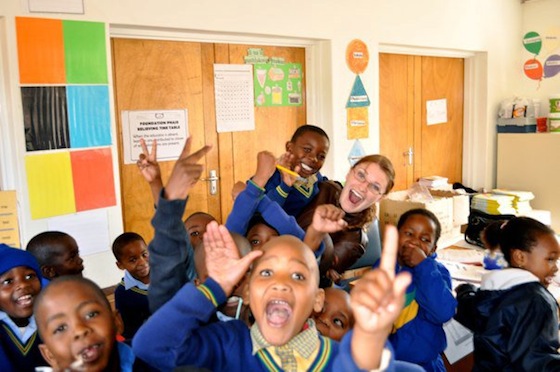Bullyproof Your Classroom with Brown Paper Bags
This is the first of several posts from inner-city middle school teacher Mackenzie Grate about building a positive classroom culture. It’s a idea to try anytime during the school year when the going gets rough.

Every teacher has experienced that moment when we feel like the culture of our classroom is either beginning a downward spiral or about to spin out of control. Bickering and disengagement are growing. Bullying is on the rise.
• Maybe we’re a rookie teacher and we’ve had the realization that we didn’t start the year off right. Panic is setting in. Will the rest of our first year be doomed to failure? Because things are really getting crazy in this classroom….
• Maybe we’re a veteran who suddenly realizes that we simply got too comfortable this year and didn’t put as much effort or time into classroom systems and routines as we normally do. Now we can feel the dynamic among the kids starting to deteriorate.
• Or perhaps we have a larger scale problem – we’re in a building where the entire school culture is out of control and we’re just trying to do our part to keep chaos from fully ensuing.
No matter what the case may be, one thing’s for sure: You have to address a classroom culture in crisis.
Here’s what worked in my classroom
Students cannot afford to wait a whole year, missing valuable instruction, with the dim hope that in the next grade “things will be different.” And that goes double for our most struggling learners, many of whom already feel alienated from the education process and are what we might describe as “cultural foreigners” in the traditional school setting.
So we must fix it. But how? How does a teacher actually stop students from bullying? How does a teacher get students to be able to value treating each other well? How does a teacher get students to recognize their part in the learning process?
Sounds cliché, but it’s simple: you teach them!
I want to share a powerful strategy that I developed in my sixth grade classroom two years ago with my co-teacher Mr. W and Connor Reed, our City Year volunteer. It’s called “Epiphany in a Paper Bag.”
Our classroom crisis came near the end of the year, and we decided that we needed to press the cultural reset button. But can you really restore sanity and civility so late in the game?
Developmentally, most middle schoolers are really only able to see how their actions affect themselves, not others. So we were naturally concerned it couldn’t be done. But then we wondered: If we could provide our students the opportunity to genuinely experience how they made other people feel – and how that made others perceive them – maybe they would reconsider their actions towards their classmates.

As students wrote, we circled the room, encouraging the process and collecting the notes. By having them write three notes, we hoped to reinforce the idea that despite negative experiences, there were positive actions being taken in our school community on a regular basis.
Then we asked our students to do the opposite. On each of the pink stickies, they wrote down something a person did that made them feel terrible, embarrassed, or angry. Similarly, because we wanted these notes to be brutally honest, we reminded the students not to include their own names. Just as before, they folded each note and wrote the name of the classmate who took the action towards them on the front.
Meanwhile, at the back of the room…

Some bags were stuffed with positive notes, some with negative notes, and some with a mixture of both. I can’t recall a single bag that didn’t have at least one post-it in it.
When the students finished their writing, the teachers began distributing the paper sacks to their owners. Students were then given the opportunity to open their paper bags and start reading the comments directly and privately.
Looking across the room you could see little smiles on the faces of the kids who had received and read the green notes. It made them feel reassured to be acknowledged for their good deeds. One student had 30+ pink stickies that he had to read through. Another student had all green stickies. Most students had several of each.
And then we shared…

After that, we opened a discussion in which we asked for volunteers to share their experiences. Much to my surprise, it was the student who got 30 pink stickies (and not a single green note) who shot up his hand first. I decided to call on him because the whole point of this exercise was to confront the issues that we had let linger a bit too long.
This student spoke candidly and said he had no idea how much he hurt his classmates. He said he thought he was being funny because everyone laughed when he said things, and he genuinely thought he was more of a “class clown.” Now he realized the kids were laughing along with him because they were scared that he might target them next.
The impact on our classroom community as this 6th grader shared these realizations about his behavior is a moment in my teaching career that I will never forget. We really got through to him.
His honesty then initiated a flood of other responses. Students began opening up about their experiences and how they really felt when their classmates said or did certain things. Even the students with all green sticky notes chimed in to talk about how difficult it is to be nice to everyone all the time, even when they don’t always get the same in return.
Our classroom culture changed for the better
The dynamic of this cohort of students shifted. It was clear that the level of vulnerability and honesty made them reevaluate their perspective on how they affected others. To this day, when I come in contact with those students from two years ago, they remember our activity and talk about how it changed them as a person.
I learned that difficult topics need to be addressed, but students also need to learn about these tough issues through actual experiences. Opportunities for safe, structured, but extremely honest feedback need to occur frequently in our schools and classes.
As the saying goes, “You may not remember exactly what someone says or does, but you will never forget how they made you feel.” Let’s create many opportunities for this generation of students to gain insight into how they feel about themselves and how they impact the feelings of others around them.
Mackenzie Grate was a Title One middle school ELA teacher and assistant principal in New York City for 16 years. She has a BA in English Education, an MS in TESOL from New York University and an MA in Educational Leadership from The College of Saint Rose. She goes by “Mack.”




































I hope this wonderful teacher shared this activity, and the result, with her students’ families. It could lead to some rich discussions at home about how we treat each other.
What if the student who had received all the pink notes, did not respond that way? I teach sophomores in high school, and I could envision one or two of them wearing that as a badge of honor…how do we get through to them? Thanks very much for this idea, I would love to try it!